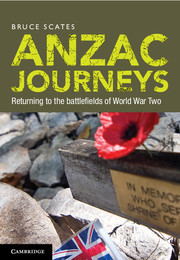Book contents
- Frontmatter
- Contents
- Maps
- Illustrations
- Acknowledgements
- Money, measurement and terminology
- Introduction
- PART 1 CAPTIVITY NARRATIVES
- 1 ‘If only I knew what has become of him’: The loss of Australia's prisoners of war
- 2 Witness to war: The first journeys
- 3 Bring up the bodies: Commemorating our war dead
- 4 Unspeakable histories: From Singapore to Hellfire Pass
- 5 The Death March: Journeys back to Sandakan
- PART 2 DESERT AND ISLAND
- PART 3 AIR AND SEA
- PART 4 AUSTRALIA'S FRONT LINE
- Conclusion
- Notes
- Index
1 - ‘If only I knew what has become of him’: The loss of Australia's prisoners of war
from PART 1 - CAPTIVITY NARRATIVES
Published online by Cambridge University Press: 05 June 2013
- Frontmatter
- Contents
- Maps
- Illustrations
- Acknowledgements
- Money, measurement and terminology
- Introduction
- PART 1 CAPTIVITY NARRATIVES
- 1 ‘If only I knew what has become of him’: The loss of Australia's prisoners of war
- 2 Witness to war: The first journeys
- 3 Bring up the bodies: Commemorating our war dead
- 4 Unspeakable histories: From Singapore to Hellfire Pass
- 5 The Death March: Journeys back to Sandakan
- PART 2 DESERT AND ISLAND
- PART 3 AIR AND SEA
- PART 4 AUSTRALIA'S FRONT LINE
- Conclusion
- Notes
- Index
Summary
More than 22 000 Australian servicemen and women were taken prisoner as Japanese forces swept through Asia and the Pacific. They shared their captivity with civilian internees as well as members of other Allied forces. Conditions in each camp were different, and survival rates varied accordingly. The Red Cross map expresses a deep desire to locate a missing loved one but, in truth, the numbers in each camp, even their location, were often a mystery. Members of Australian forces were also taken prisoner by Axis troops in Europe, but their experience has not loomed quite so large in national mythology.
In January 1946, barely a few months after the fighting in the Pacific had ended, E.V. Britnell, secretary of the Australian Prisoners of War Relatives Association, wrote (yet again) to the Prime Minister: ‘We are being asked by members of the Association who have had the misfortune to have their relatives die whilst prisoners of war in territories which were formally occupied by the Japanese, when it will be possible to visit their graves.’ Misfortune was an understatement, as Britnell knew full well. Families who lost loved ones in Japanese POW camps suffered a terrible ordeal. Since 1942, and the fall of Singapore, they had lived in a state of chronic anxiety, never knowing whether a son or daughter was alive or dead, fearing but not knowing the worst, unwilling to give up hope, unable to grieve.
- Type
- Chapter
- Information
- Anzac JourneysReturning to the Battlefields of World War Two, pp. 16 - 27Publisher: Cambridge University PressPrint publication year: 2013



